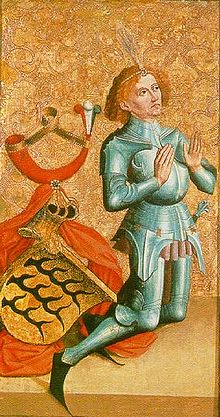
Elisabeth of Bavaria-Landshut, daughter of Henry XVI of Bavaria and Margarete of Austria
Ernest I, Prince of Anhalt-Dessau (died Dessau, 12 June 1516), was a German prince of the House of Ascania and ruler of the principality of Anhalt-Dessau. He was the second son of George I, Prince of Anhalt-Dessau, but the first born by his fourth wife Anna, daughter of Albert VIII, Count of Lindow-Ruppin.
Margarete (b. Breslau, 25 August 1473 - d. Dessau, 28 June 1530), daughter of Henry I, Duke of Münsterberg-Oels, and granddaughter of George of Poděbrady, King of Bohemia.
Joachim I Nestor (21 February 1484 – 11 July 1535) was a Prince-elector of the Margraviate of Brandenburg (1499–1535), the fifth member of the House of Hohenzollern. His nickname was taken from King Nestor of Greek mythology.
The eldest son of John Cicero, Elector of Brandenburg, Joachim received an excellent education under the supervision of Dietrich von Bülow, Bishop of Lebus and Chancellor of Frankfurt University

Elizabeth of Denmark, Norway, and Sweden (24 June 1485 – 10 June 1555) was a Scandinavian princess who became Electress of Brandenburg as the spouse of Joachim I Nestor, Elector of Brandenburg. She was daughter of King Hans of Denmark, Norway and Sweden and his spouse, Christina of Saxony.
As a child, Elizabeth had a close relation with her brother, the later King Christian II of Denmark. She was able to read and write in both Danish and German. On 10 April 1502 she married Joachim I Nestor, Elector of Brandenburg, in a double wedding alongside her uncle, the future king Frederick I of Denmark, and her sister-in-law Anna of Brandenburg. Elizabeth and Joachim got along quite well during the first twenty years of their marriage and co-existed harmoniously. She received her mother in 1507, attended her brother Christian's wedding in 1515 and received Christian in 1523.

Frederick I of Liegnitz (3 May 1446 – 9 May 1488), was a Duke of Chojnów and Strzelin from 1453, of Oława and Legnica from 1454, of Brzeg from 1481 and of Lubin from 1482. Frederick was born in Brzeg. He was the only son of John I, Duke of Lubin, by his wife Hedwig, daughter of Ludwik II of Brzeg.
Ludmila of Poděbrady (Polish: Ludmiła Podiebrad; (16 October 1456 – Legnica, 20 January 1503), was a member of the House of Poděbrady and by marriage Duchess of Chojnów-Oława-Legnica-Brzeg-Lubin.
She was the youngest daughter of George of Poděbrady (who was elected King of Bohemia in 1458) by his second wife, Johana of Rožmitál (Johanka z Rožmitálu). She was named after her maternal grandmother, Ludmila Bawor of Strakonicz.
John II (German: Johann II.; 2 August 1455 – 9 January 1499) was Elector of Brandenburg from 1486 until his death, the fourth of the House of Hohenzollern. After his death he received the cognomen Cicero, after the Roman orator Cicero, but the elector's eloquence and interest in the arts is doubtful.[1]
John Cicero was the eldest son of Elector Albert III Achilles of Brandenburg with his first wife Margaret of Baden. As his father then ruled as Margrave of Brandenburg-Ansbach (from 1457 also as Margrave of Brandenburg-Kulmbach), he was born at the Hohenzollern residence of Ansbach in Franconia, where he spent his childhood years until in 1466 he received the call toBrandenburg as presumed heir by his uncle Elector Frederick II. He joined him in the Stettin War of Succession with the Pomeraniandukes, until Frederick resigned in 1470 and was succeeded by John's father, who in 1473 appointed him regent of the Brandenburg lands. After the Pomeranian struggle he also had to deal with the inheritance conflict upon the 1476 death of the Piast duke Henry XI of Głogów, husband of his half-sister Barbara.
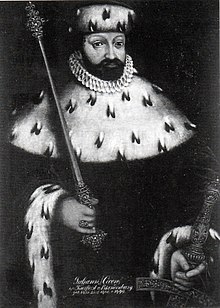
Margaret of Saxony (1449 – 13 July 1501) was a German noblewoman, Electress of Brandenburg by marriage.
She was the daughter of William III, Duke of Luxemburg, and Anne, Duchess of Luxembourg.

John, also known as Hans; né Johannes[1] (2 February 1455 – 20 February 1513) was King of Denmark (1481–1513), Norway(1483–1513) and as John II (Swedish: Johan II) of Sweden (1497–1501) in the Kalmar Union, and also Duke of Schleswig andHolstein. The three most important political goals of King John were the restoration of the Kalmar Union, reduction of the dominance of the Hanseatic League, and the building of a strong Danish royal power.
He was born at Aalborghus, in Aalborg, the son of Christian I of Denmark and Dorothea of Brandenburg, daughter of Margrave John of Brandenburg. In 1478, he married Christina of Saxony, granddaughter of Frederick the Gentle of Saxony. This produced the following offspring: Christian II, Francis, Knud, and Elisabeth, who later married as princess of Brandenburg. From about 1496 until 1512, he had a relationship with Edele Jernskjæg.

Christina of Saxony (b. Torgau, 25 December 1461 – d. Odense, 8 December 1521), was a Saxon princess who became Queen consort of Denmark, Norway, and Sweden. She was born a granddaughter of Frederick the Gentle of Saxony, and daughter ofErnest, Elector of Saxony and Elisabeth of Bavaria. She was the grandmother of Christina of Denmark through her son Christian II.

Henry (Latin Henricus; 14 June 1463 – 23 June 1514, Leer), Duke of Brunswick-Lüneburg, called Henry the Elder or Henry the Evil, was prince of Wolfenbüttel from 1491 until his death.
Henry's father, William IV, Duke of Brunswick-Lüneburg, retired in 1491, leaving government of Wolfenbüttel to his two sons, Henry the Elder, and Eric. In 1494, the brothers divided the territory between them, and Henry received the eastern part of the state, with the cities of Brunswick and Wolfenbüttel.
Catherine of Pomerania-Wolgast (German: Katherine von Pommern-Wolgast) (c. 1465–1526) was the wife of Henry IV, Duke of Brunswick-Lüneburg, Prince of Wolfenbüttel. She was the daughter of Eric II, Duke of Pomerania-Wolgast, and Sophia of Pomerania-Stolp.
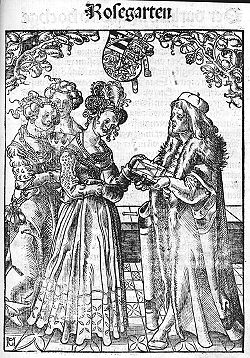
Karl I of Hohenzollern (1516 in Brussels – 18 March 1576 at Sigmaringen Castle) was Count of County of Hohenzollern from 1525 to 1575. He was Imperial Archchamberlain and chairman of the Aulic Council.
Karl was the eldest son of the Count Eitel Friedrich III of Hohenzollern (1494–1525) from his marriage to Johanna van Witthem (d. 1544), daughter of Philip, Lord of Beersel and Boutersem. Karl was Imperial Archchamberlain and later chairman of the Aulic Council. In 1534, he received the Counties of Sigmaringen and Veringen as imperial fiefs from Emperor Karl V.
Anna (1512–1579), a daughter of Margrave Ernst of Baden-Durlach
Count Froben Christoph of Zimmern (19 February 1519 – 27 November 1566) was the author of the Zimmern Chronicle and a member of the von Zimmern family of Swabian nobility. This article is based primarily on Beat Rudolf Jenny's biography of him.[1]
Froben Christoph was born at Mespelbrunn Castle in the Spessart as the son of Johann Werner and his wife Katharina of Erbach. He was raised there and in Aschaffenburg by his step-grandfather Philipp Echter and his grandmother, the Countess of Werdenberg.
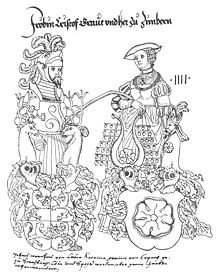
Honorato Hurtado de Mendoza y Manrique, Marqués de Cañete 1425-85 Hijo de Juan Hurtado de Mendoza Guzmán, 2do. Marqués de Cañete y Inés Manrique
Francisca Silva Rivera 1414 y 1474 Hija de Juan Gomes de Silva, 1º conde de Cifuentesy Inés de Rivera
Conde. Cristobal de Briceño, Señor de Piquillos y Villaquejida 1452 y 1512 Hijo de Juan de Briceño, Señor de Villaquejida yBeatriz de la Torre
Isabel della Caprona 1445 y 1505
Christophe Ier de Bade (en allemand, Christoph von Baden), né le 13 novembre 1453 et mort le 19 avril 1527 àHohenbaden.
Il fut margrave de Bade de 1475 à 1515.Fils de Charles Ier de Bade et de Catherine d'Autriche (1420-

Erik Johansson Vasa (1470 – 8 November 1520) was the Lord of Rydboholm Castle in the Roslagen. He was born around the year 1470 to Johan Kristiernsson Vasa and Birgitta Gustafsdotter Sture in a village named Örby in the province of Uppland,Sweden. He was one of four children from Johan and Birgitta; Johan was first cousin of Charles VIII of Sweden's father, Knut.

Cecilia Månsdotter Eka (c. 1476–1523), also called Cecilia of Eka, was a Swedish noblewoman. She was the spouse of Erik Johansson Vasa and mother of King Gustav I of Sweden.
Cecilia was born around 1476 in Eka, Lillkyrka, which is now known as Eka, Örebro County in Sweden. She was the oldest of the two children from the nobles Sigrid Eskilsdotter Banér and Magnus Karlsson Eka. Her mother later remarried, and became the mother of the famous Christina Gyllenstierna in her second marriage, who was thereby Cecilia's half sister
Ebba Eriksdotter Vasa (died 21 November 1549) was a Swedish noble. She was the mother of Queen Margaret Leijonhufvud andKing Märta and mother-in-law of King Gustav Vasa.
Ebba was the daughter of nobleman Erik Karlsson (Vasa) and noblewoman Anna Karlsdotter (Vinstorpa). Her father was a cousin ofErik Johansson Vasa, the father of King Gustav Vasa. She was married to riksråd Erik Abrahamsson Leijonhufvud on 18 January 1512 in Söderköping. In 1520, her spouse was executed during the Stockholm Bloodbath.
Federico di Ansbach e Bayreuth, conosciuto anche coi nomi di Federico I o Federico V (Ansbach, 8 maggio 1460 – Ansbach, 4 aprile 1536), era figlio maggiore del margravio Alberto III di Brandeburgo e della sua seconda moglie, Anna, figlia di Federico II di Sassonia.
Suo fratellastro maggiore fu Giovanni il Cicerone di Brandeburgo. Federico succedette al padre come margravio di Ansbach nel 1486 e a suo fratello minore, Sigismondo, come margravio di Bayreuth nel 1495.
ofia Jagellone (6 aprile 1464-5 ottobre 1512), figlia del re Casimiro IV di Polonia e di sua moglie Elisabetta d'Asburgo e sorella del re Sigismondo I di Polonia
Eric I di Brunswick-Lüneburg, detto "il Vecchio", in tedesco Erich I, der Ältere (Neustadt am Rübenberge, 16 febbraio 1470 –Haguenau, 30 luglio 1540), fu duca di Brunswick-Lüneburg dal 1495 e principe regnante di Calenberg-Gottinga.
Nacque il 16 febbraio 1470 nel castello di Rovenburg a Neustadt am Rübenberge. Fu il fondatore della linea di Calenberg della casa di Brunswick-Lüneburg: suo padre, Guglielmo IV, era morto nel 1503, ma già nel 1495 aveva diviso le sue terre tra i figli Enrico ed Eric. Eric ricevette così i principati di Calenberg e Gottinga, mentre Enrico ottenne il ducato di Brunswick-Wolfenbüttel.

Elisabetta di Brandeburgo (Cölln, 24 agosto 1510 – Ilmenau, 25 maggio 1558) è stata una principessa del Brandeburgo, duchessa consorte di Brunswick-Calenberg-Göttingen escrittrice.
Era la terza figlia del principe elettore Gioacchino I di Brandeburgo (1484–1535) e di sua moglie Elisabetta (1485–1555), figlia del re Giovanni di Danimarca.
Ricevette un'educazione strettamente religiosa e umanistica.
Entrò per la prima volta in contatto con Riforma nel 1527 quando sua madre introdusse nella corte gli insegnamenti di Martin Lutero scatenando le reazioni violente di suo padre che cacciò via da Wittenberg tutti i riformatori.

Casimiro di Brandeburgo-Bayreuth (Ansbach, 27 dicembre 1481 – Buda, 21 settembre 1527) fu Margravio di Bayreuth dal 1515 alla propria morte.
Egli era figlio del Margravio Federico I e di sua moglie, la Principessa Sofia di Polonia, figlia del ReCasimiro IV Jagellone.
Dal 1498, suo padre gli aveva concesso la posizione di statolder del marchesato durante i suoi lunghi viaggi. Egli governò sotto la guida di esperti consulenti. Nel 1515, Casimiro e suo fratello Giorgio deposero il padre, che aveva notevolmente appesantito le finanze del marchesato con il suo stile di vita sontuoso. Siccome suo fratello fu spesso alla corte ungherese, Casimiro governava il Brandeburgo-Ansbach anche a suo nome.

Susanna di Wittelsbach (Monaco di Baviera, 2 aprile 1502 – Neuburg, 23 aprile 1543) fu una nobilebavarese.
Era figlia di Alberto IV di Baviera, duca di Baviera, e Cunegonda d'Austria. Le venne messo il nome di una sorellina nata nel 1499 e morta ad un anno.
Fu data in sposa a Casimiro di Brandeburgo-Bayreuth, margrevio del Brandeburgo-Kulmbach dal 1515al 1527. Il matrimonio venne celebrato il 25 agosto 1518.

John of Saxony (30 June 1468 – 16 August 1532), known as John the Steadfast or John the Constant, was Elector of Saxonyfrom 1525 until 1532. He was a member of the House of Wettin.
Born in Meissen, he was the fifth of the seven children of Ernest, Elector of Saxony and Elisabeth of Bavaria.
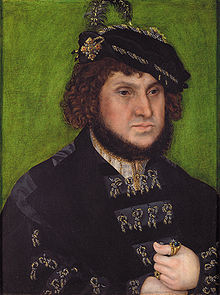
Sophie of Mecklenburg, also spelled Sophia (18 December 1481 – 12 July 1503 in Torgau) was a German noblewoman. She was a Duchess of Mecklenburg by birth and by marriage Electoral Princess of Saxony.
Sophie was the third of seven children and the second daughter of Duke Magnus II of Mecklenburg and his wife Sophie of Pomerania.
John III the Peaceful, Duke of Cleves and Count of Mark (John III, Duke of Cleves; John I, Duke of Jülich-Berg; German:Johann III der Friedfertige, Herzog von Jülich-Kleve-Berg; 10 November 1490 – 6 February 1538/9) was a son of John II, Duke of Cleves and Mathilde of Hesse, daughter of Henry III, Landgrave of Upper Hesse.[
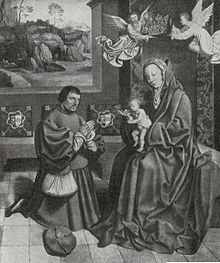
Maria of Jülich-Berg (3 August 1491 – 29 August 1543) was born in Jülich, the daughter of Wilhelm IV, Duke of Jülich-Berg andSibylle of Brandenburg.[1]
John Frederick I (German: Johann Friedrich I; Torgau, 30 June 1503 – Weimar, 3 March 1554), called John the Magnanimous, was Elector of Saxony and Head of the Protestant Confederation of Germany (the Schmalkaldic League), "Champion of the Reformation".
John Frederick was the eldest son of Elector John by his first wife, Sophie of Mecklenburg-Schwerin. His mother died fourteen days after his birth, on 12 July 1503

Sibylle of Cleves (German: Sibylle von Jülich-Kleve-Berg) (17 January 1512 – 21 February 1554) was Electress consort of Saxony.
Born in Düsseldorf,[1] she was the eldest daughter of Johann III of the House of La Marck, Duke of Jülich jure uxoris, Cleves, Bergjure uxoris, Count of Mark, also known as de la Marck and Ravensberg jure uxoris (often referred to as Duke of Cleves) who died in 1538, and his wife Maria, Duchess of Julich-Berg (1491–1543). Her younger siblings were two sisters, Anna (later Queen of England) and Amalia, and a brother, Wilhelm, who became in Duke of Jülich-Cleves-Berg, bearing the promising epithet "The Rich

Count Palatine Wolfgang of Zweibrücken (German: Pfalzgraf Wolfgang von Zweibrücken; 26 September 1526 – 11 June 1569) was member of the Wittelsbach family of the Counts Palatine and Duke of Zweibrücken 1532–1559.
He was the only son of Louis II, Count Palatine of Zweibrücken and his wife Elisabeth of Hesse, daughter of William I, Landgrave of Hesse. His father died in 1532, so the regency of Palatinate-Zweibrücken passed to Louis' younger brother Rupert until 1543. In 1557 Wolfgang received the territory of Palatinate-Neuburg in accordance with the Contract of Heidelberg. In 1548 the Holy Roman Emperor Charles V occupied his Protestant territories and reintroduced Catholic practices. This imposition ended in 1552. ThePeace of Augsburg of 1555 ended the religious conflict, and in 1557 several ecclesiastical states in Germany were secularised, a few of which Wolfgang obtained. In 1566 he served as a cavalry officer in the Turkish Wars.

Anna of Hesse (26 October 1529, Kassel – 10 July 1591, Meisenheim) was a princess of Hesse by birth and marriage Countess Palatine of Zweibrücken.
Anna was a daughter of Landgrave Philip I of Hesse (1501–1567) from his marriage to Christine (1505–1549), a daughter of Duke George of Saxony.
Henry (Latin: Henricus; 10 November 1489 – 11 June 1568), Duke of Brunswick-Lüneburg, called the Younger, (also called Heinrich der Jüngere) was Prince of Wolfenbüttel from 1514 until his death. The last Catholic of the Welf princes is known for the large number of wars in which he was involved.
He was born at Wolfenbüttel Castle, the son of Duke Henry IV of Brunswick-Lüneburg, Prince of Wolfenbüttel, known as Henry the Elder. Henry V became ruling duke when his father was killed in battle in 1514, and soon entered into the Great Diocesan Feud with the Bishopric of Hildesheim under John IV of Saxe-Lauenburg, against whom he lost the Battle of Soltau in 1519. However, the duke profited from his support of Charles V in the succession as Holy Roman Emperor, and in 1523 the Bishopric had to cede large territories to Wolfenbüttel. Henry remained loyal to the Imperial authority during the German Peasants' War, and in 1528 he assisted Emperor Charles V in the War of the League of Cognac against King Francis I of France in Italy.
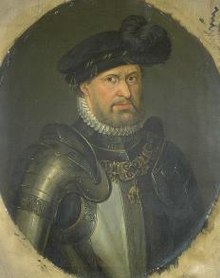
Carlos II de Baden-Durlach, en alemán Karl II von Baden-Durlach (Pforzeim, 24 de julio de 1529 - Durlach, 23 de marzo de 1577), fue Margrave de Baden-Durlach desde 1563 hasta su muerte. Carlos era hijo del Margrave Ernesto I de Baden-Durlach y de su esposa Úrsula de Rosenfeld. Carlos militó en la facción protestante alemana y estuvo entre los principales del Sacro Imperio Romano. En 1555 introdujo los principios de la Reforma en Baden-Durlach, Estado que había heredado al morir su padre en 1553.
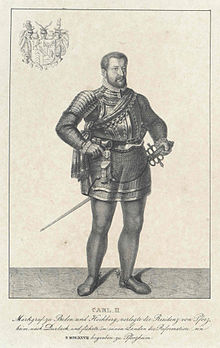
lexander of Zweibrücken (German: Pfalzgraf Alexander von Zweibrücken "der Hinkende") (26 November 1462 – 21 October 1514) was Count Palatine and Duke of Zweibrücken and of Veldenz in 1489–1514.
He was the son of Louis I, Count Palatine of Zweibrücken and his wife Johanna of Croÿ. Alexander promised to establish a church after the successful return from a crusade, and it was kept in 1489 with the building of the Alexanderskirche in Zweibrücken.
Margarete of Hohenlohe-Neuenstein, daughter of Count Kraft VI of Hohenloheand Helene of Württemberg.
John V the Conqueror KG (in Breton Yann V, in French Jean IV) (1339 – 1 November 1399) was Duke of Brittany and Count of Montfort from 1345 until his death and 7th Earl of Richmond from 1372 until his death.
He was the son of John de Montfort and Joanna of Flanders. His father claimed the title John IV, Duke of Brittany, but was largely unable to enforce his claim for more than a brief period. Because his father's claim to the title was disputed, the subject of this article has often been numbered John IV, while his father has been referred to as simply "John de Montfort" (Jean de Montfort). English historians number him as John V, since the English king recognized his father's title. In France he is commonly known as John IV, since the French monarchy, unlike the English, never acknowledged his father's title.
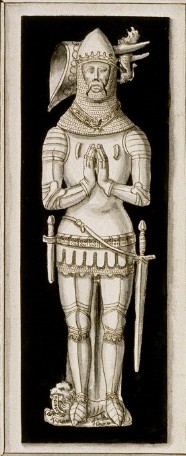
Juana de Navarra (Pamplona, 10 de julio de 1370 - Havering Bower, Essex, 9 de julio de 1437) fue Reina Consorte de Inglaterra, como esposa del rey Enrique IV.
Fue la sexta de los 7 hijos de Carlos II el Malo, rey de Navarra, y de Juana de Francia. Siendo sus abuelos maternos Juan II el Bueno yBona de Luxemburgo.

Carlos VI de Francia (París, 3 de diciembre de 1368 – 21 de octubre de 1422), conocido como Carlos el Bien Amado o Carlos el Loco, era hijo de Carlos V y de Juana de Borbón. Sucedió a su padre en el trono francés a la edad de 11 años. Al nacer fue nombrado Señor del Delfinado. Desde entonces se instituyó la costumbre y tradición de dar el título de Delfín al hijo mayor del rey francés.

Isabel de Baviera (1370–1435) fue reina consorte de Francia después de casarse el 17 de julio de 1385 con Carlos VI de Francia. Durante la Guerra de los Cien Años, desempeñó un importante papel en la guerra civil entre los borgoñones y los Armagnacs.
Isabel de Baviera era hija del duque Esteban III de Baviera y Tadea Visconti, hija del Duque de Milán, Bernabé Visconti.

Roberto III (¿?, 1340 - ¿?, 4 de abril de 1406); rey de Escocia (reinó de 1390 a 1406). Fue primogénito del rey Roberto II de Escocia con su esposa, Elizabeth Mure, llegaron a casarse formalmente por sus padres en 1349. (Ellos se habían casado anteriormente en 1336, pero algunos criticaron que la ceremonia no era canónica).

Anabella Drummond (Dunfermline, h. 1350 - Scone, octubre de 1401), fue reina consorte de Roberto III de Escocia.
Era hija de Sir John Drummond de Stobhall y Mary Montifex. Se casó con Juan Estuardo (el futuro Roberto III) en 1367, y fuecoronado con su esposo en el Palacio de Scone cuando ascendió al trono en 1390.
El burgo de Fife de Inverkeithing fue una residencia favorita de la reina. Su presencia aún se recuerda en la fuente de piedra caliza, decorada con ángeles y heráldica, que ella regaló a la iglesia parroquial de la ciudad, una de las piezas más bellas de escultura tardomedieval de Escocia.

John Beaufort, 1st Marquess of Somerset and 1st Marquess of Dorset, later only 1st Earl of Somerset, KG (c. 1373 – 16 March 1410) was the first of the four children of John of Gaunt, 1st Duke of Lancaster, and his mistress Katherine Swynford, whom he married in 1396. Beaufort's surname probably reflects his father's lordship of Beaufort in Champagne, France.[2][3][4]
The Beaufort children were declared legitimate twice by parliament during the reign of King Richard II of England, in 1390 and 1397,[5] as well as by Pope Boniface IX in September 1396.[6] Even though they were the grandchildren of Edward III and next in the line of succession after their father's legitimate children by his first two wives, the Beauforts, including John Beaufort, were initially barred from succession to the throne.[7]
Margaret Holland, Countess of Somerset (1385 – 31 December 1439) was the daughter of Thomas Holland, 2nd Earl of Kent, who was the son of Joan "the Fair Maid of Kent" (granddaughter of Edward I of England, wife of Edward the Black Prince and mother of Richard II of England). Margaret's mother was Alice FitzAlan, daughter of Richard FitzAlan, 10th Earl of Arundel and Eleanor of Lancaster.
Ernst was founder of the Ernestine line of Saxon princes, and a direct patrilineal ancestor of Prince Albert of Saxe-Coburg and Gotha. He was the second son (but fourth in order of birth) of the eight children of Frederick II, Elector of Saxony and Margaret of Austria, sister of Frederick III, Holy Roman Emperor.

Elisabeth of Bavaria-Munich (2 February 1443 in Munich – 5 March 1484 in Leipzig) was a princess of Bavaria-Munich by birth and by marriage Electress of Saxony.
Elizabeth was a daughter of the Duke Albert the Pious of Bavaria-Munich (1401–1460) from his marriage to Anna of Brunswick-Grubenhagen-Einbeck (1420–1474), daughter of the Duke Eric I of Brunswick-Grubenhagen.
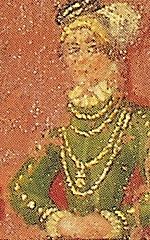
John II, "The Pious" or "The Babymaker", Duke of Cleves, Count of Mark, (German: Johann II. "der Pious" oder "der Kindermacher", Herzog von Kleve, Graf von Mark) (1458–1521) was a son of John I, Duke of Cleves and Elizabeth of Nevers. He ruled Cleves from 1481 to his death in 1521. He was called "The Babymaker" since he fathered sixty-three illegitimate children [1]before his marriage with Mathilde of Hesse in 1490.

Mathilde of Hesse (4 July 1473 in Blankenstein – 19 February 1505 in Cologne) was the daughter of Henry III, Landgrave of Upper Hesse (1441-1483) and his wife Anna of Katzenelnbogen (1443-1494).
William IV of Jülich-Berg (9 January 1455 – 6 September 1511) was the last ruler of the Duchy of Jülich-Berg.
William was the son of Gerhard VII, Duke of Jülich-Berg and Sophie of Saxe-Lauenburg. When his father died in 1475, William became Duke of Jülich-Berg.
Sibylle of Brandenburg (31 May 1467 in Ansbach – 9 July 1524 in Kaster) was a Princess of Brandenburg by birth and by marriage Duchess of Jülich and Duchess of Berg.
Sibylle was a daughter of Elector Albrecht III Achilles of Brandenburg (1414–1486) from his second marriage to Anna (1436–1512), daughter of the Elector Frederick II of Saxony.
john I (German: Johann I.) (15 May 1459 – 27 January 1509) was the Count Palatine of Simmern from 1480 until 1509.
John was born in 1459 to Frederick I, Count Palatine of Simmern. He married Joanna of Nassau-Saarbrücken the daughter ofJohann II of Nassau-Saarbrücken on 29 September 1481. John died in Starkenburg in 1509 and was buried in Simmern.
Christoph I of Baden (13 November 1453 – 19 April 1527) was the Margrave of Baden from 1475 to 1515.
Christoph was the eldest son of Karl I, Margrave of Baden-Baden and Catherine of Austria, a sister of Frederick III, Holy Roman Emperor. He built the New Castle and moved there in 1479. In 1515 he divided his possessions between his sons Bernhard, Philipp and Ernst. Thus, Bernhard founded the so-called "Bernardine line" of Baden-Baden and Ernst founded the "Ernestine line" ofBaden-Durlach.

Ottilie of Katzenelnbogen (ca. 1451[1] – 15 August 1517, Baden-Baden), was by marriage Margravine of Baden-Baden.
She was the only child of Philipp II the Younger of Katzenelnbogen (1427 – 27 February 1453) and Ottilie of Nassau-Dillenburg (April 1437 – July 1493). Her baptism took place one month after her father's death, on 22 March in Starkenburg Castle, near Darmstadt.
Philipp II the Younger was in turn the eldest of the two sons of Count Philipp I of Katzenelnbogen the Elder (1402 – 1479) and his first wife, Anna of Württemberg (1408 – 1471).
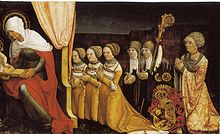
Henry the Elder of Münsterberg (also called Henry I of Münsterberg, Henry I of Oels; Czech: Jindřich starší z Minstrberka orJindřich starší z Poděbrad; German: Heinrich der Ältere von Münsterberg or Heinrich I. von Oels; 1448 – 1498, Kłodzko) was anImperial Count and Count of Kladsko. He was also Duke of Silesian duchies Münsterberg and Oels and 1465–1472 Duke of Opava. At times, he served as the Landeshauptmann and governor of Bohemia.
Henry was descended from the Poděbrady branch of the Kunštát family. His parents were King George of Poděbrady of Bohemia and Kunigunde of Sternberg. In order of siblings Henry was the third son after the older brothers Boček and Victor.

Ursula of Brandenburg (25 September 1450 – 25 November 1508, Breslau) was a princess of Brandenburg by birth and by marriage Duchess of Münsterberg and Oels and Countess of Glatz.
Ursula was the eldest child of the Elector Albrecht Achilles of Brandenburg (1414–1486) from his first marriage to Margarete of Baden (1431–1457). The princess was considered a favorite child of her father and one of the most prominent victims of the marriage of convenience in the 15th century. First, she had been promised to Duke Albert the Brave of Saxony. When he broke off the engagement, she was passed on to his older brother, Ernest. When this engagement was also dissolved, the next marriage candidate was Duke Henry the Elder of Münsterberg-Oels (1448–1498), son of the Bohemian king George of Poděbrady. In 1466 Pope Paul IIdisapproved of the engagement as a "blasphemous connection with a heretic", and Ursula and her father were excommunicated. The relations between Brandenburg and Emperor Frederick III also worsened due the engagement.[1] George of Poděbrady and Abrecht Achilles created a defensive alliance against all the opponents of the marriage. Ursula then secretly became engaged to Count Rudolph III of Sulz, Landgrave in Klettgau, without telling her father.
Louis II of Zweibrücken (German: Pfalzgraf Ludwig II. von Zweibrücken-Neuburg "der Jüngere") (14 September 1502 – 3 December 1532) was Count Palatine and Duke of Zweibrücken from 1514 to 1532.
He was the son of Alexander, Count Palatine of Zweibrücken and his wife Margarete of Hohenlohe-Neuenstein. He was married in 1525 to Elisabeth of Hesse, daughter of William I, Landgrave of Lower Hesse, and they had two children. His son Wolfganginherited the title and his daughter Christine died young in 1534. Louis II was buried in the Alexanderskirche in Zweibrücken.
Elisabeth of Hesse (4 March 1503 – 4 January 1563, Lauingen) was a Landgravine of Hesse by birth and by marriage Countess Palatine of Zweibrücken and later Countess Palatine of Simmern.
Elizabeth was the youngest of five daughters of Landgrave William I of Hesse (1466–1515) from his marriage to Anna of Brunswick-Wolfenbüttel (1460–1520), daughter of Duke William II of Brunswick-Wolfenbüttel. Elizabeth was raised as a Protestant. In 1518, she was kidnapped by just Landgrave Philip I of Hesse, who had just come of age, to prevent a marriage which her mother Anna had planned, but which Elisabeth herself was opposed to.[1]
Sigismund I of Poland (Polish: Zygmunt I Stary; Lithuanian: Žygimantas I Senasis) (1 January 1467 – 1 April 1548), of the Jagiellon dynasty, reigned as King of Poland and also as the Grand Duke of Lithuania from 1506 until 1548. Earlier, Sigismund had been invested as Duke of Silesia. A successful monarch and a great patron of arts, he established Polish suzerainty over Ducal Prussia (East Prussia) and incorporated the duchy of Mazovia into the Polish state, securing the nation's wealth, culture and power.
Sigismund I, the fifth son of Casimir IV and Elisabeth of Habsburg, had ruled Głogów, Silesia, since 1499 and became margrave of Lusatia and governor of all Silesia in 1504. In a short time his judicial and administrative reforms transformed those territories into model states. He succeeded his brother Alexander I as grand prince of Lithuania and king of Poland in 1506. Although he established fiscal and monetary reforms, he often clashed with the Polish Diet over extensions of royal power. At the Diet’s demand he married Barbara, daughter of Prince Stephen Zápolya of Hungary, in 1512, to secure a defense treaty and produce an heir. She died three years later, however, leaving only daughters. In 1518 Sigismund married the niece of the Holy Roman emperor Maximilian, Bona Sforza of Milan, by whom he had one son, Sigismund II Augustus, and four daughters. His daughter Catherine later married John III of Sweden, from whom the Vasa kings of Sweden were descended.[1]
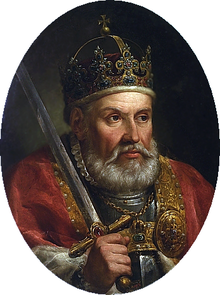
Barbara Zápolya (1495–1515) was Queen of Poland and Grand Duchess of Lithuania as the first wife of King Sigismund I the Old. Marriage to Barbara represented an alliance between Sigismund and the House of Zápolya against the Habsburgs in succession disputes over the throne to the Kingdom of Hungary. The alliance was short-lived as the renewed Muscovite–Lithuanian War forced Sigismund to look for Habsburg allies. The marriage was loving, but short. Barbara was the mother of Hedwig, Electress of Bradenburg, but died soon after the birth her second daughter Anna.
She was the daughter of Stephen Zápolya, Palatine of Hungary and Count of Szepes, and the Polish princess Hedwig of Cieszyn of the Piast dynasty.[1] Barbara was a younger sister of John Zápolya, the future King of Hungary. The family was known for their wealth – Stephen had more than 70 castles in Hungary and Slovakia.[2] Her father died in 1499, leaving the family in care of Hedwig's cousin, Casimir II, Duke of Cieszyn. Barbara probably spent her childhood in the Trenčín Castle and the court of Anne of Foix-Candale, Queen of Bohemia and Hungary.[1]

No hay comentarios:
Publicar un comentario